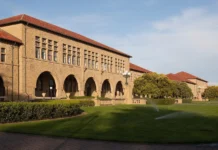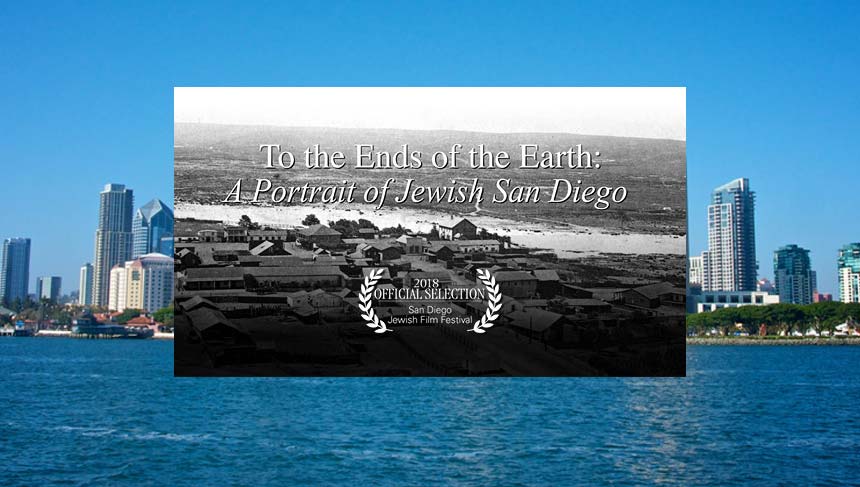SAN DIEGO – Isaac Artenstein’s newest documentary, To The Ends of the Earth: A Portrait of Jewish San Diego, which is on sale at the San Diego History Center in Balboa Park, tapped present and past Jewish leaders of San Diego to narrate the story of 168 years of Jewish settlement in the southwestern corner of the continental United States.
Viewers of the 75-minute documentary not only hear from Joellyn Zollman, curator of the History Center’s soon to close exhibition about San Diego Jewry, but also from such luminaries as Rabbis Scott Meltzer, Wayne Dosick, and Simcha Weiser; past and present members of Congress Lynn Schenk and Susan Davis; Qualcomm co-founders Andrew Viterbi and Irwin Jacobs; Irwin’s wife Joan Jacob, who with her husband is a major philanthropist; poet Jerome Rothenberg and his wife Diane; Dr. Peter Salk, son of polio vaccine discoverer Jonas Salk; Robert Price, son of big box marketing guru Sol Price of Fedmart and Price Club fame; art critic Robert Pincus; Ratner Clothing granddaughter Marcia Hazan; Rancho La Puerta and New Americans Museum founder Deborah Szekely; real estate developer Jeff Silberman, and Yardage Town executive Lucy Goldman, among others.
The documentary also includes commentary from Zollman’s fellow historian and academics such as Lawrence Baron, the former head of SDSU’s Lipinsky Institute for Judaic Studies; Journal of San Diego History editor Iris Engstrand; Adolph Levi biographer Rob Levi (a direct descendant); Levi’s cousin and History Center trustee Debby Cushman Parrish; Stan and Laurel Schwartz of the Jewish Historical Society of San Diego; and Janet Klauber, who related tales of the pioneer Klauber family. I also made an appearance in the documentary, mainly in my capacity as the biographer of San Diego’s first Jewish settler, Louis Rose, who arrived in 1850.
Others on camera included Pamela Nathan of the South African Jewish American Community (SAJAC); Doron Jaffe of Coastal Roots; Alberto Cohen of the Mexican Jewish community; Solomon Maya and Becky Margolis of the Ken Jewish Community; musician, ethnomusicologist and documentary maker Yale Strom; Esther Belinksy and Fred Belinksy, both of the Arnold’s Furniture Company family (whose advertising tagline was “from our family to yours”), and Sarah Price-Keating, daughter of Robert Price, who portrayed Victoria Jacobs, the teenager who lived in San Diego during the 1850s and left behind her diary.
Victoria Jacobs, who later married Maurice Franklin, never realizing how important her diary some day would become to local historians, painted a picture of a well-integrated Jewish family who observed the major Jewish holidays and who also mixed easily with the early society of San Diego.
The point was made that there were far bars to the Jews of San Diego in mid-19th Century San Diego. They were leading merchants, and were elected to positions of public trust. They served on the City Board of Trustees (equivalent to today’s City Council); the County Board of Supervisors; the Grand Jury; and various other boards and commissions that helped to develop the region from what must have seemed to them, and others who subsequently arrived here, as “the ends of the earth.”
From the discussion of pioneer days, the film transitions to the late 19th Century, characterized by the emergence of the Gaslamp Quarter where Old West legend Wyatt Earp and his Jewish wife, Sarah Marcus, opened businesses after Earp’s famous Gunfight at the OK Corral in Tombstone, Arizona. Viewers also are treated to a visual and verbal essay by Robert Pincus on the works of early Jewish visual artists in San Diego, among them Alice Klauber, Maurice Braun, Belle Baranceanu, and Harry Sternberg.
Onward goes the documentary to the 20th century, which brought the great military presence to San Diego along with new business opportunities and many more permanent residents. This also was the time that Szekely and her husband, Edmund, an advocate of vigorous exercise and diet, established Rancho La Puerta across the border in Tecate, Mexico. Deborah later would go on to become even more famous as the operator of the Golden Door Spas.
Before and after World War II, San Diego, once so accepting of Jews, had its share of anti-Semitism. There was the more virulent kind as exemplified by a publication called The Broom, which followed the Nazi line about superior and inferior races; and the more genteel kind, such as a conspiracy by real estate brokers to steer Jews away from La Jolla, even though such practices were illegal. This led to a discussion of how realtors changed their ways after learning that UC San Diego might not be built in La Jolla unless the practice ended. Rabbi Dosick told of moving Congregation Beth El from the Clairemont neighborhood to La Jolla, notwithstanding the ugly resistance he encountered from community leaders – if you have ever wondered why you can’t make a left turn directly into Beth El’s parking lot from Gilman Drive,
The chronological narration included various vignettes, such as Robert Price telling how his father, Sol, thought of himself as a fiduciary for his employees and his customers. Notwithstanding that Price Club prices were lower (as are those of its successor company, Costco) and its employees well paid, the company made profits through the efficient management of inventory. Others included Peter Salk talking about his father Jonas’s decision to locate the Salk Institute for Biological Studies in La Jolla; and Marcia Hazan relating how the Ratner family moved from hats to pants, uniforms, and later to ownership of the Hang Ten trademark.
Attention also is given in the documentary to various ethnic groups within the Jewish community, such as the Jews who migrated here from South Africa and Mexico. The film mentions but does not elaborate upon significant Jewish immigration to this area as well from Israel and Iran. Artenstein, who earlier in his career produced a documentary on the Jews of Tijuana, did not forget to include visuals and interviews about San Diego’s next door neighbor, highlighting an interview with Congresswoman Susan Davis about the importance of the inter-relationship of the two cities.
Seventy five minutes may seem like a long time for a documentary – clearly it’s too long for an hour slot on television – but to me it was amazing how seamlessly Artenstein was able to include so many voices, covering so much history, in so short a time. He really did a wonderful job transitioning from one voice to another, and bringing so much history together, so that we not only saw and heard all these luminaries talk, but—through the magic of the extensive photo collection of the San Diego History Center—we could also view the subject matter they were talking about.
The History Center’s exhibition on the Jews of San Diego comes to a close on June 3rd of this year. Thanks, however, to Artenstein’s skillful documentary, many parts of it live on. Soon, curator Zollman, who was an excellent narrator in the film, will be bringing out a catalog of the exhibition, including a timeline of San Diego history, which, no doubt, will prove to be an important companion piece. That too will be on sale at the San Diego History Center.
Republished from San Diego Jewish World
























